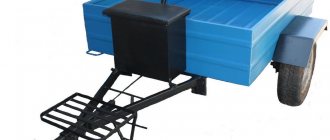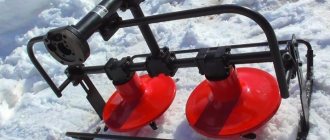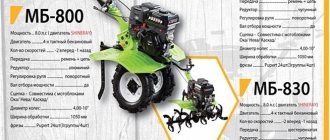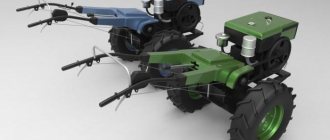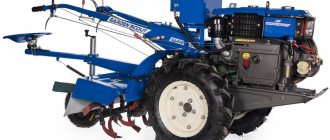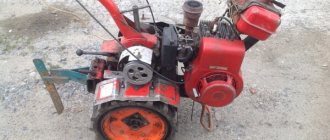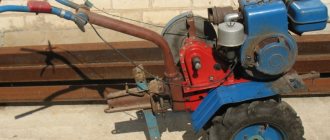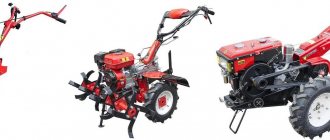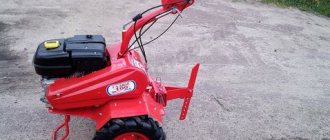Motoblocks appeared everywhere not so long ago. Just 30 years ago they were not produced in our country. The reason for this is simple - on collective farms, which were the main form of farming in the USSR, the land was cultivated with powerful tractors. Only a few “Kulibins” created something like a walk-behind tractor for cultivating their personal plot using improvised means. Such homemade products immediately became the envy of all fellow villagers. Of course, a hand-held, multifunctional tool for cultivating land is just the dream of a Soviet farmer or summer resident.
But with the collapse of the USSR, a new era began - the time of walk-behind tractors. Large farms began to disintegrate. Private household plots and small farms began to take their place. For such farms, buying a full-fledged tractor is very difficult, and often there is no need. The walk-behind tractor coped well with all the work, replacing several types of equipment at once.
With the growing popularity of walk-behind tractors, the number of their manufacturers and models has also grown. At the moment, the variety of this technology is so great that it is very difficult to make a choice.
What kind of work can a walk-behind tractor perform? Attachments
Those who have never used a walk-behind tractor assume that its functions are limited to soil cultivation. But this is far from the case, and the happy owners of this “mini-tractor” can use it to perform the following work:
Plowing the land
With the help of a special small plow, which is an attachment for a walk-behind tractor, they actually plow the land. The greater the power of the walk-behind tractor, the more efficient the plowing. So the most powerful models can be safely sent to raise virgin soil.
A walk-behind tractor can significantly save energy and time for summer residents and owners of small farms. It allows you to plow the land quickly and with sufficient quality. In this case, you can forget about the pain of using a shovel or hiring a tractor that will shovel the entire area, leaving behind many huge clods.
In addition, the quality of soil cultivated with a walk-behind tractor is much higher than when plowed with a shovel or even a motor-cultivator. The reason for this is the opening of the deep layers of the soil and thorough mixing of the soil. This allows you to properly saturate the soil layer with oxygen, and as a result, increase the productivity of the land.
Harrowing
The walk-behind tractor can be equipped with another type of attachment - a harrow. A harrow is a special attachment with teeth.
When harrowing with a walk-behind tractor, the top dry earth crust, which is formed when the soil dries out under the influence of the sun, is crushed.
Harrowing is one of the most effective methods of weed removal.
The importance of harrowing is to create the opportunity for oxygen to reach the plant roots. In addition, without this procedure, moisture saturation of the plant root system is disrupted.
Hilling
Any gardener who grows potatoes or, say, strawberries will certainly appreciate such a function of the walk-behind tractor as hilling. With the help of a mounted hiller, the walk-behind tractor is able to raise furrows to ventilate the tubers.
Planting and harvesting
Potato lovers will not be able to contain their emotions from two more attachments for the walk-behind tractor. This is a potato planter and potato digger. Planting and harvesting potatoes with a walk-behind tractor is much faster.
In addition, there are special seeders on the market for sowing seeds of almost any garden plants.
Shipping
By connecting a walk-behind tractor with a trailer, you can get a kind of motor scooter. Yes, its speed will not be great. But it will transport loads like a real mini-tractor - you will be amazed at what this little guy is capable of.
He is not afraid of bags of cement, bales of fertilizer, or mountains of your harvest. And you yourself will be able to move around almost in complete comfort - sitting on your “heel” and imagining yourself as either a tractor driver or a coachman.
Winter work of the walk-behind tractor
In winter, the walk-behind tractor can be easily equipped into a snow removal machine. In this case, you can use a whole set of attachments.
For example, after a heavy snowfall, a snow blower is suitable for clearing walkways. A walk-behind tractor equipped with this tool can easily shovel even deep snow and throw it on the side of the road.
If the snowfall was light and the snow has not yet compacted, snow brushes are suitable and will help clean all the footpaths.
To remove hardened, compacted snow, you can use a special snow shovel. It is equipped with knives to remove compacted snow.
Motoblock device
A walk-behind tractor is actually a fairly simple mechanical tool. It consists of several main components: engine, transmission, clutch, gearbox and power take-off shaft.
Let's look at them in more detail.
Motoblock engine. Modern walk-behind tractors are equipped with three types of engines: gasoline, diesel or electric.
Electric walk-behind tractors are rare. This is due to the fact that their power is low, and therefore their functionality is limited.
Diesel walk-behind tractors are the most powerful, but also the most expensive. Although they are more economical than gasoline ones, they are also more reliable. But everything is determined by the high price - that’s why you don’t often see them in ordinary Russian households.
But walk-behind tractors with a gasoline engine are the most common.
Walk-behind tractor transmission. It is a system of components that is designed to transmit torque from the engine to the wheels and working body of the walk-behind tractor. There are several types of transmissions that are installed on different types of walk-behind tractors.
Lightweight walk-behind tractors are usually equipped with a worm-gear transmission. It includes two gearboxes: gear (upper) and worm (lower). Sometimes such transmissions are equipped with a power take-off shaft.
A belt-tooth-chain transmission is most often installed on medium-power walk-behind tractors. In it, the rotation of the engine is transmitted to the gearbox shaft via a belt. At the same time, the gearbox shaft supplies torque to the attachment or wheels through the chain. And finally, a gear transmission is installed on heavy walk-behind tractors. Its design is in many ways similar to a tractor transmission. Thanks to the gear transmission, walk-behind tractors have several speeds (both forward and reverse).
Gearbox. This is a detail that you should pay attention to when choosing and purchasing a walk-behind tractor. The gearbox directly affects the reliability and service life of the “mini-tractor”. It serves to transfer power from the engine shaft to the working part of the walk-behind tractor.
Models with a collapsible gearbox are preferable. Such gearboxes are repairable. In addition, if only part of the unit fails, it can be easily replaced rather than buying a new walk-behind tractor.
PTO. This mechanism is inherited by the walk-behind tractor from the tractor. This unit is necessary for the operation of attachments.
What is the power of the walk-behind tractor, and how to choose it?
It is based on the power factor that all walk-behind tractors are divided into three types.
Types of walk-behind tractors depending on power
So, as we have already indicated earlier, all walk-behind tractors according to power parameters are divided into:
- lungs;
- average;
- heavy;
Light Motoblocks
This type of walk-behind tractor has engines with a power of up to 5 horsepower. Due to their low power, they are practically incapable of performing heavy work with a plow on hard ground, as they quickly overheat and cannot drag the plow.
Light walk-behind tractors are also suitable for light work on small private farms - loosening and cultivating light soil.
Medium Motoblocks
This is a more serious technique with an average engine power of up to 8 horsepower. They are often equipped with a multi-speed transmission and reverse gear.
Equipping with a power take-off shaft allows medium walk-behind tractors to use attachments. Diesel models are already appearing in this line of walk-behind tractors.
Heavy Motoblocks
These machines are already more like a mini-tractor. And no wonder - their weight often exceeds 100 kg, and the engine develops power of over 10 horsepower.
All heavy walk-behind tractors are equipped with a power take-off shaft and are ready to work with any attachments.
Large walk-behind tractors have advanced characteristics that undoubtedly exceed the capabilities of light or medium-sized walk-behind tractors. In addition, they are more reliable due to the use of components with higher wear resistance.
The performance of such machines is also impressive - some models are capable of working for days in the literal sense of the word.
Of course, all these advantages are significantly reflected in the price of a heavy walk-behind tractor. Although, if the size of your farm is large enough, and the list of necessary work is constantly growing, then buying a heavy walk-behind tractor can significantly save you effort, time, and subsequently money.
Honda
It was the GX engine family developed by Honda that became, in fact, the standard for engines of this class and a subject for constant copying.
The Honda motor for the walk-behind tractor is part of the GX line, from the compact GX120 to the quite serious GX390, although the company also produces more powerful versions of this engine.
| Model | Volume, cm3 | Power, hp | Peculiarities | Price |
| GX120 | 118 | 3,5 | The most compact and lightest engine in the series. | 25100 |
| GX160 | 163 | 4,8 | Most Chinese engines and a huge selection of non-original spare parts are based on this engine. | 26070 |
| GX200 | 196 | 5,5 | 27710 | |
| GX240 | 270 | 7,9 | Automatic change of ignition timing depending on speed. | 45260 |
| GX270 | 270 | 8,4 | An upgraded version of the GX240 with increased power. | 45930 |
| GX340 | 389 | 10,7 | 54080 | |
| GX390 | 389 | 11,7 | Forced version of GX340 | 52210 |
How to choose a walk-behind tractor?
The choice of walk-behind tractor directly depends on the area of the area being processed, the type and volume of work.
If you know the power of the walk-behind tractor and the area of the plot, it is easy to calculate the number of hours of work required to process this plot. Based on the data in the table below, you can determine the required power of the walk-behind tractor.
In addition, you should take into account the fact that more powerful walk-behind tractors are usually more reliable.
When thinking about how to choose a walk-behind tractor, pay attention to user reviews. And reviews say that domestic walk-behind tractors are less reliable and durable than imported ones. Although this rule covers all mechanical engineering.
Therefore, when choosing a domestic walk-behind tractor, you should clarify the data on the maintainability of the selected agricultural machine.
Device Features
You can buy a walk-behind tractor in almost any store for your garden or garden. It is no longer something unique. It is used not only for working in the fields, the product also shows excellent results when cleaning the area.
But it is important to understand that the walk-behind tractor will not last even a season if the engine is not maintained or used incorrectly. In addition, it is important to pay attention to the company that produced the motor, since not all of them produce high-quality models.
Tips for buying a walk-behind tractor
As with the purchase of any equipment, the price of a walk-behind tractor directly depends on its equipment.
How to choose a walk-behind tractor? - according to your needs and financial capabilities. The cheapest is the basic package. The more equipment installed on a unit, the correspondingly higher its price. In connection with the above, before purchasing a walk-behind tractor, clearly highlight and write down the tasks that this unit should perform on your farm. Based on the list of tasks, choose a model and equipment.
When choosing a walk-behind tractor model, check what is already included in the basic package of the machine. Different models may have different equipment, even in the basic configuration.
Carefully calculate the required power of the walk-behind tractor. Consider the type of soil on your site. For light, loose soil, you can choose a lower engine power for the walk-behind tractor. If the soil is heavy and dense, you will have to turn your choice towards more powerful models.
Having chosen a specific walk-behind tractor model, check what warranty period is provided for the equipment. An important point is the presence of a service center serving this brand in your region.
As for additional attachments, you shouldn’t rush into butter like a cat and buy everything at once. Usually, at first, only equipment for cultivating the soil is purchased. The rest is purchased as needed. This way you can save a decent amount.
What is called a stroke in an internal combustion engine?
A stroke on an internal combustion engine is an action that takes place inside the mechanism. Moving the piston in the upper or lower direction is the stroke. Moreover, one stroke is when the piston moves upward, performing the corresponding work. The downward movement of the piston, which returns from the force generated by the combustion of fuel, is called the power stroke.
The first stroke from which the engine begins to operate is filling the cylinder with the fuel mixture. The next stage is the compression of the incoming mixture into the engine. Next, ignition occurs, and finally the removal of burnt gases. These are the four strokes that are performed in four-stroke engines. The crankshaft in four-stroke units makes two revolutions with one ignition of the fuel.
Two-stroke engines operate in two cycles - transporting the fuel mixture into the cylinder with its subsequent ignition, and removing exhaust gases from the cylinder. In two-stroke units, the crankshaft makes one revolution when burning one portion of the fuel mixture.
This is the main difference between the units under consideration and each other.
2-stroke and 4-stroke internal combustion engines are available in gasoline and diesel fuel types. To find out in detail what advantages and disadvantages are available in the 2- and 4-stroke engines under consideration, let us consider their design and operating principle.
Popular walk-behind tractor models
Russian walk-behind tractors
In the group of light and medium walk-behind tractors, we can highlight the Neva MB-1B-6.0FS . This model has an affordable price - an average of 45,000 rubles with fairly good equipment.
The developed one allows the walk-behind tractor to operate in three forward gears and one reverse gear. And with the help of a folding flap, you can rearrange the belt, which adds additional gears.
Characteristics of Neva MB1-B-6.0FS
- Engine: Briggs&Stratton RS950 made in USA 4-stroke
- Power: 6 hp
- Weight: 75 kg
- Number of gears: (3+1)x2
- Cultivation width (grab): 86-127 cm
- Tillage depth: 20 cm
- Fuel: gasoline
Another model of the Neva walk-behind tractor is MB1-N "MultiAgro" . This agricultural tool is designed for work in small and medium-sized areas with loamy soil.
The MB1-N "MultiAgro" walk-behind tractor demonstrates high traction capabilities with lower power consumption.
Characteristics of MB1-N "MultiAgro"
- Engine: Honda made in Japan
Power: 5.8 hp
- Weight: 75 kg
- Number of gears: (3+1)x2
- Cultivation width (grab): 86-127 cm
- Tillage depth: 20 cm
- Fuel: gasoline
Luch MB1 (Oka MB1) - a walk-behind tractor was developed back in the 80s of the last century. It is distinguished by simplicity of design, strength and wear resistance of the structure and high maintainability.
Despite the fact that the Luch MB1 walk-behind tractor does not claim to be the ideal agricultural machinery, its design has been successfully adopted and similar equipment is successfully produced under other brands by a number of domestic and Chinese manufacturers. The reason for this is the versatility of the walk-behind tractor.
Designed Beam MB-1 is intended for processing small plots of land in private household plots and in the country. It works well on light soils, but gets noticeably “tired” on clay soils.
The disadvantages of the Luch walk-behind tractor include its high weight. Only a physically trained person can handle such a heavy machine.
Characteristics of the walk-behind tractor Luch MB-1 (Oka MB-1)
- Engine: DM-1 4-stroke manufactured in Russia (analogues of the walk-behind tractor are equipped with foreign engines)
- Power: 5 HP
- Weight: 100 kg
- Number of gears: (3+1)x2
- Cultivation width (grab): 71-120 cm
- Tillage depth: 20 cm
- Fuel: gasoline
According to user reviews and statistics, the second place in popularity in Russia after the Neva is occupied by Salyut .
The main advantage of the Salute walk-behind tractor is the gear reducer. The thing is that such gearboxes are usually installed only on heavy walk-behind tractors, and medium-power machines are equipped with a chain drive. This gearbox is able to withstand heavy loads and has increased resistance to external impacts of stones and hard clods of earth.
The low center of gravity of the walk-behind tractor protects it from tipping over. In addition, the Salyut is equipped with easily removable steering wheel and wheels, which reduces its assembly and disassembly time and increases transportability.
Characteristics of the Salyut 5/Salyut 100 walk-behind tractor
- Engine: 4-stroke Honda GX200 Japan / LIFAN 168F-2B / Briggs&Stratton Vanguard 6.5
- Power: 6.5 hp
- Weight: 78 kg
- Number of gears: 4 forward, 2 reverse
- Cultivation width (grab): 36-80 cm
- Tillage depth: 25 cm
- Fuel: gasoline
Japanese walk-behind tractors are the best walk-behind tractors in the world
Kubota is one of the most reliable manufacturers. The most popular model, the Kubota K1-8, will allow you to process even large areas. The model has a low noise level. But the main advantage of walk-behind tractors is their compactness.
Characteristics of the Kubota K1-8 walk-behind tractor
- Engine: 4-stroke Honda GX200 Japan / LIFAN 168F-2B / Briggs&Stratton Vanguard 6.5
- Power: 8 hp
- Weight: 160 kg
- Number of gears: 4 forward, 2 reverse
- Water cooling
If you need a lighter walk-behind tractor, then you should pay attention to the Cayman .
Motoblocks from this manufacturer have high reliability and maintainability. And the 3-year warranty is good news.
Characteristics of Cayman walk-behind tractors
- Engine: Subaru EP 17 OHC 2 or 4 stroke
- Power: 5-7 hp
- Number of gears: 2 forward, 1 reverse
Which walk-behind tractor should I buy and how to maintain it?
Pros and cons of European engines
European-made engines, which are distinguished by high build quality, components, power reserves and functionality, are popular among both domestic and foreign consumers. In terms of quality, versatility, and reliability, engines of Italian and German production stand out.
Motors produced in Europe are equipped with reliable starting devices and have a good power reserve. The service life of such products is more than 1500 hours when performing tasks of any complexity. This is due to the fact that they are made from high-quality components and materials. Also, the advantages of European-made engines include:
- Power.
- Build quality.
- Reliable air filtration system.
- High indicators of environmental safety and reliability.
The main disadvantage of engines that were produced in Europe is their cost. In this regard, European engine models are inferior to Chinese and even some Japanese counterparts.
Conclusion
You need to approach the choice of a walk-behind tractor responsibly in order to avoid disappointment later.
Before you buy a walk-behind tractor, you need to calculate in detail all the equipment parameters that you will need based on the following factors:
- area of the treated area;
- soil type;
- required range of work;
- What attachments will you need first?
Based on the above, you can choose the type of walk-behind tractor and its power.
The main differences between two-stroke and four-stroke internal combustion engines
One of the main differences between the units under consideration is the presence of a gas distribution mechanism on a 4-stroke engine. There is no gas distribution mechanism on 2-stroke devices. Instead, there are holes in the cylinder walls, through which the finished fuel-air mixture is supplied, as well as exhaust gases are removed.
The timing belt not only increases the weight and size of the engine, but also significantly affects its cost. The absence of a timing belt results in the engine having only two operating cycles. The presence of channels in the cylinder walls leads to increased wear of the engine rings and piston. This is why two-stroke engines have a short service life. Next, let's look at the design differences between 2-stroke and 4-stroke engines.
Regarding the lubrication system of four-stroke engines, it should be noted that they come in two types - dry and wet sump. They differ in the method of lubrication. In the wet type, oil is supplied from the crankcase to the crankshaft. The pump pumps oil from the crankcase, which is part of the engine.
Dry sump internal combustion engines use a separate oil tank. From it, oil is pumped into the crankshaft system, ensuring lubrication of the parts. The accumulated oil is transported back to the tank using an additional pump.
